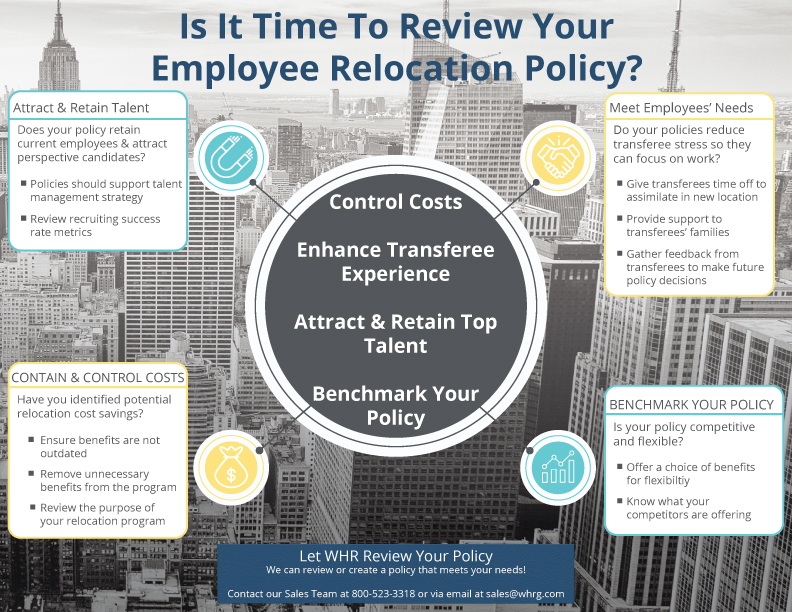Given the many changes businesses have encountered from COVID-19, including employees working remotely, you might think there’s no reason to review your company’s employee relocation policy right now. Well, think again. Many companies are still relocating employees to fill needed roles. Reviewing your policy and making needed adjustments now can help your organization in the following areas:
- Maîtriser les coûts de l'entreprise
- S'assurer que vous répondez aux besoins des employés
- Attirer et retenir les meilleurs talents
- Analyse comparative Votre politique par rapport à la concurrence
The following examples are from policy reviews WHR Global conducted for its clients. These examples demonstrate just how important it is to review your relocation policy on a regular basis.
A. Maîtriser les coûts des entreprises et cesser de payer pour des avantages inutiles
Make sure you’re allocating the right amount of dollars to both transferees and organizational needs. It’s also essential that you’re not paying for unnecessary or outdated benefits.
- Exemple 1
Uneentreprise dont nous avons examiné la politique donnait à chaque personne transférée une somme forfaitaire standard de 5 000 à 10 000 dollars pour la réinstallation afin de couvrir les dépenses supplémentaires. Elle accordait également aux cadres une somme forfaitaire égale à six semaines de salaire en plus de la somme forfaitaire de 5 000 à 10 000 dollars. Comme certains cadres avaient des salaires élevés, cette allocation équivalait parfois à 50 000 $ par cadre ! Après examen, nous avons recommandé à l'entreprise de réduire cette pratique pour les cadres. L'entreprise a économisé des centaines de milliers de dollars. - Example #2
A client was paying a cost of living differential if the employee was relocating to a higher cost area. They were paying this out for 3–4 years, plus they were also providing a big lump sum benefit. We recommended a minimum 5% cost of living threshold so that they were not paying transferees moving to only slightly higher cost of living areas. The client saved millions. - Example #3
Another client was giving out non-promotional bonuses to current employees willing to relocate for a lateral role. These bonuses equated to 5% of the employees’ salaries. Since this practice is not common, we recommended they eliminate this from their relocation policy, which saved them significant costs without lowering the value of their program. - Example #4
One of our clients was paying a loan origination fee. Some lenders don’t even charge this fee, but if they know the client will pay, they will still charge the fee anyway. Once the client realized this, they stopped paying the fee unless necessary.
B. Répondez aux besoins de vos employés
It’s important that your relocation policy meets your transferees’ needs. This helps to reduce transferee stress so that employees can focus on work in their new location. Giving transferees time off to assimilate in their new location, providing support to transferees’ families, and gathering post-relocation feedback to make future policy decisions will all help to address your transferees’ needs.
- Example #1
One of our clients was offering a lump sum benefit for all international relocations. By gathering post-relocation survey feedback, we found out transferees were trying to coordinate their own international household goods (HHG) shipments and were not spending the full lump sum, in hopes of keeping some money. The survey feedback also showed that giving employees that level of choice was adding more stress on them, and it was making the relocation process take longer. Basically, transferees were trying to do it all on their own plus pinch pennies. The client considered all key benefits and determined the lump sum was not working. They shifted from a lump sum to a core flex benefit. This meant the client would cover HHG shipments, destination service providers and temporary housing, but they still gave transferees a lump sum amount to be used at the employees’ discretion. Not only did this help reduce transferee stress, but it also helped control business costs.
- Example #2
One client was not offering destination services to the spouses/partners and families of intra-European moves. They assumed that if a transferee/family was relocating from Russia to the UK, for example, destination services were not needed. Through post-relocation survey feedback, it was determined that spouses/partners required career assistance, language training and help with school searches for their children. The employee had office workers to help them assimilate in the new locations, but the transferees’ partners were struggling with the new language and even struggling to find necessities like grocery stores. Recognizing the needs of the entire family unit, and not just the transferee, is crucial to ensuring a successful move and assimilation.
C.Attirer et retenir les talents et comparer votre politique avec celle de la concurrence
Avec un peu de chance, votre politique de relocalisation fait déjà partie de votre stratégie de rémunération globale et de gestion des talents. Une politique appropriée aidera votre entreprise à conserver ses employés actuels et à attirer des candidats potentiels. Une politique de relocalisation insuffisante pourrait avoir un impact négatif sur le taux de réussite de votre recrutement.
Benchmarking your policy against other companies will help you stay competitive in the war for talent. Make sure your policy provides a choice of offerings, since relocation policies are wrapped into job offers. If you don’t benchmark against your competitors, you won’t know if your offerings are good or not. Are they subpar to what everyone else is offering? If you are hiring high level executives, for example, and the talent is very specific and not easy to come by, you’ll want to make sure you’re competitive with salary, benefits, and your relocation policy.
At the same time, benchmarking will ensure you’re not giving away too much when none of your competitors are doing that. Benchmarking your policy against others shows you are in line with the industry. It’s also important to not only look at your industry, but also other industries you compete with for talent.
- Example #1
Imagine losing a potential candidate because your relocation policy is missing benefits your competitors are including. For example, if your candidate is an executive expecting a full buyout, but your policy only includes a HHG move and lump sum payout, then you have to go back and forth negotiating with your superiors and the candidate. This can waste a lot of time. In the interim, the candidate might receive a better job offer, including more relocation benefits. A relocation policy can be a factor for candidates deciding whether to take one job over another. If you’ve benchmarked your policy against your competition, you’ll already know what their policies include.
- Exemple n° 2
Unclient recevait des commentaires de son équipe d'acquisition de talents selon lesquels il était difficile de pourvoir certains postes. Après avoir examiné leur politique et l'avoir comparée à celle de leurs concurrents, nous avons découvert que ces derniers offraient des avantages de réinstallation bien plus importants. En conséquence, l'entreprise a décidé d'élargir sa gamme de postes donnant droit à des avantages complets en matière de réinstallation.
D. À quelle fréquence devez-vous revoir votre politique ?
WHR recommends you review your employee relocation policy annually or every couple of years at the very longest. It does not have to be a huge overhaul, but it’s a chance for you to pause and look at employee feedback. Additionally, you should confirm any changes in your company culture, driving principles, core values, talent strategy, the industry, and your competition. The review is a time for you to make sure your policy is aligned with all of those pieces and your key stakeholders (talent acquisition teams, recruiting teams, HR business partners).



